
Georgetown is the third oldest city in the U.S. state of South Carolina and the county seat of Georgetown County, in the Lowcountry. As of the 2010 census it had a population of 9,163. Located on Winyah Bay at the confluence of the Black, Great Pee Dee, Waccamaw, and Sampit rivers, Georgetown is the second largest seaport in South Carolina, handling over 960,000 tons of materials a year, while Charleston is the largest.
Paul Trapier (1749–1778) was a public official in South Carolina during the American Revolution.

The Falls Church is an historic Episcopal church, from which the city of Falls Church, Virginia, near Washington, D.C., takes its name. Established in 1732, the parish in 1769 built a brick church building that remains in use today.
Doar is the surname of an aristocratic family in the southern United States. Prior to the American Civil War, family members were among the largest landowners in the South. The family's fortune in the U.S. originates mainly from plantations in Charleston, Georgetown, Berkeley, Orangeburg, Barnwell and Beaufort Counties, South Carolina. Among the plantations that the Doar family owned are: Doar Plantation, Doar Point Plantation, Palo Alto, Harrietta, Woodville, Walnut Grove, Montgomery, Oak Grove, Buck Hall, Egremont, Elmwood, Woodside, Hopsewee, Wedge and Windsor.

St. James' Church, Goose Creek, also known as the Goose Creek Church, is an Episcopal church at 100 Vestry Lane in Goose Creek, South Carolina. Built in the 1710s, it is one of South Carolina's oldest surviving buildings, and one of a small number of surviving early Georgian chapels in the nation. It was declared a National Historic Landmark in 1970.
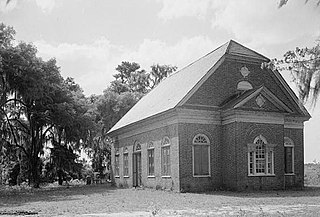
PompionHill Chapel is small "back parish" church near Huger, South Carolina. Built in 1763, it is a virtually unaltered example of a brick Georgian parish church, retaining interior and exterior finishes. It was declared a National Historic Landmark in 1970.

St. Michael's AnglicanChurch is a historic church and the oldest surviving religious structure in Charleston, South Carolina. It is located at Broad and Meeting streets on one of the Four Corners of Law, and represents ecclesiastical law. It was built in the 1750s by order of the South Carolina Assembly. It is listed on the National Register of Historic Places and is a National Historic Landmark.

St. Stephen's Episcopal Church is a historic church located at 196 Brick Church Circle in St. Stephen, South Carolina. Built in the 1760s, it is one of a handful of surviving 18th-century brick parish churches in the state, with a number of architectural features not found on any other of the period. It was declared a National Historic Landmark in 1970.
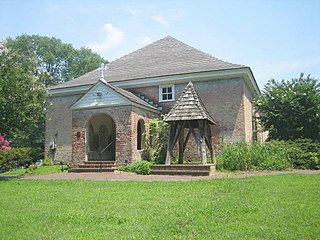
St. John's Church, St. John's Episcopal Church, or St. John's Episcopal Church, Broad Creek, is a historic Episcopal church located at 9801 Livingston Road in Fort Washington, Prince George's County, Maryland. It is a rectangular Flemish bond brick structure with a bell hipped roof. The interior features a barrel vaulted ceiling with an intricate support system.
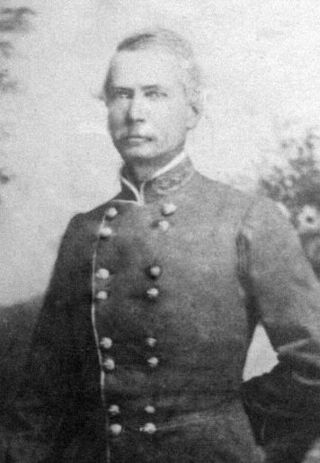
James Heyward Trapier was a career United States Army officer who fought during the Mexican–American War. He also served as a Confederate general during the American Civil War, dying shortly after its conclusion.
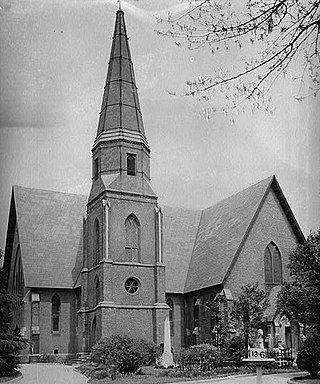
Christ Church (Episcopal) is an Episcopal church in Greenville, South Carolina, United States. which was consecrated in 1854. The church and its courtyard are listed on the National Register of Historic Places as Christ Church (Episcopal) and Churchyard. It is the oldest organized religious body and the oldest church building remaining in Greenville.

Strawberry Chapel is a parochial chapel of ease in the lower part of St. John's, Berkeley Parish in Berkeley County, South Carolina that was built in 1725. It is on Strawberry Chapel Road between South Carolina State Highway 8-44 and the West Branch of the Cooper River. Bordering Strawberry's property is the South Carolina State owned historic site of the “Town of Childsbury.” It was a planned community that was settled in 1707. The town no longer exists. They were named to the National Register of Historic Places on April 26, 1972.

Temple Beth Elohim is a Reform Jewish synagogue located at 230 Screven Street in Georgetown, South Carolina, in the United States.

St. Paul's Church, Edenton, is a historic parish church in Edenton, North Carolina. The building, which dates from 1760, is listed on the National Register of Historic Places. The churchyard has the tombs of governors Charles Eden (1673–1722), Thomas Pollock (1654–1722), and Gabriel Johnston (1699–1752).

Saint Andrew's Parish Church is located in Charleston, South Carolina, along the west side of the Ashley River. Built in 1706 it is the oldest surviving church building south of Virginia. Its historic graveyard dates from the church's establishment. Expanded in 1723 into the shape of a cross, the church is the only remaining colonial cruciform church in South Carolina. In 1973 it was placed on the National Register of Historic Places. Old St. Andrew's, as it is commonly called, remains an active place of worship and is affiliated with the Anglican Diocese of South Carolina and the Anglican Church in North America.
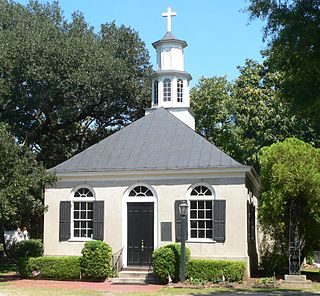
Christ Episcopal Church is a church located in Mount Pleasant, South Carolina.

All Saints Church Pawleys Island is a historic church complex and national historic district located on Pawleys Island, Georgetown County, South Carolina. The district encompasses three contributing buildings and one contributing site—the sanctuary, cemetery, rectory, and chapel. In 2004, it left the Episcopal Church to join the Diocese of the Carolinas, now part of the Anglican Church in North America, a denomination within the Anglican realignment movement.

Battery White was an artillery battery constructed by the Confederates during the American Civil War. Built in 1862–63 to defend Winyah Bay on the South Carolina coast, the battery was strongly situated and constructed; however, it was inadequately manned, and was captured without resistance during the final months of the war.

Georgetown Historic District is a national historic district located at Georgetown, Georgetown County, South Carolina. The district encompasses 49 contributing buildings in the central business district of Georgetown. The oldest existing structure in Georgetown is a dwelling which dates from about 1737. There are approximately 28 additional 18th century structures as well as 18 buildings erected during the 19th century prior to the American Civil War. The existing structures—homes, churches, public buildings—are of both historical and architectural significance and are situated on heavily shaded, wide streets. The architecture ranges from the simplicity of early colonial, or Georgian, to the elaborate rice plantation era, such as Classical Revival. Notable buildings include the Georgetown County Courthouse, U.S. Post Office, The Rice Museum, Winyah Indigo Society Hall, Masonic Lodge, Antipedo Baptist Church Cemetery, Prince George Winyah Episcopal Church complex, St. Mary's Catholic Church, Kaminski Building, Mary Man House, Dr. Charles Fyffe / Middleton House, John Cleland / Allston House, Samuel Sampson / Henning-Ward House, Robert Stewart / George Pawley House, Martha Allston Pyatt /John S. Pyatt House, Eleazar Waterman / Withers House, and William Waties / Withers House.




















